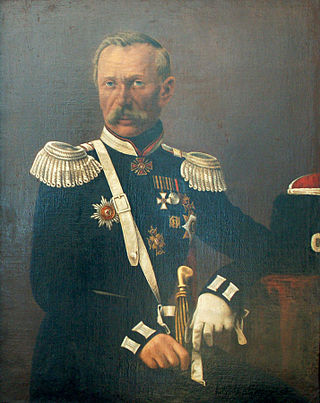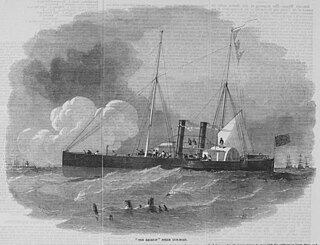
The Crimean War was fought from October 1853 to February 1856 between the Russian Empire and an ultimately victorious alliance of the Ottoman Empire, France, the United Kingdom, and Sardinia-Piedmont.

The Sea of Azov is an inland shelf sea in Eastern Europe connected to the Black Sea by the narrow Strait of Kerch, and is sometimes regarded as a northern extension of the Black Sea. The sea is bounded by Russia on the east, and by Ukraine on the northwest and southwest, currently under Russian occupation. It is an important access route for Central Asia, from the Caspian Sea via the Volga–Don Canal.

A gunboat is a naval watercraft designed for the express purpose of carrying one or more guns to bombard coastal targets, as opposed to those military craft designed for naval warfare, or for ferrying troops or supplies.

The Azov campaigns of 1695–1696, were two Russian military campaigns during the Russo-Turkish War of 1686–1700, led by Peter the Great and aimed at capturing the Turkish fortress of Azov with the aim of controlling the southern mouth of the Don River gaining access to the Sea of Azov and entrance to the Black Sea. Despite stubborn resistance and heavy casualties, the Russians under General Sheremetev after a failed siege in 1695 managed to capture the fort, accompanied by a naval force, in July 1696, marking the first major Russian victory against the Turks.

The Russo-Turkish War of 1735–1739 between Russia and the Ottoman Empire was caused by the Ottoman Empire's war with Persia and continuing raids by the Crimean Tatars. The war also represented Russia's ongoing struggle for access to the Black Sea. In 1737, the Habsburg monarchy joined the war on Russia's side, known in historiography as the Austro-Turkish War of 1737–1739.

Black Sea Cossack Host, also known as Chernomoriya, was a Cossack host of the Russian Empire created in 1787 in southern Ukraine from former Zaporozhian Cossacks. In the 1790s, the host was re-settled to the Kuban River. It comprised the Caucasus Fortified Defence Line from the mouth of the Kuban River to the mouth of the Bolshaya Laba River.

Azov Cossack Host was a Cossack host that existed on the northern shore of the Sea of Azov, between 1832 and 1862.

The southern Russian city of Taganrog began as one of Russia's first planned cities under Peter the Great. To protect the newly conquered Sea of Azov region, the Russians opened a naval base there in 1698 and a city and seaport were built. However, after the Turkish victory in the war of 1710–1711, Taganrog city and port were demolished prior to handover to the Turks.

The siege of Petropavlovsk was a military operation in the Pacific theatre of the Crimean War. The Russian casualties are estimated at 115 soldiers and sailors killed and seriously wounded, whilst the British suffered 105 casualties and the French 104.

Ivan Ivanovich Krasnov Russian: Краснов, Иван Иванович (1802–1871) was a Russian general and author.

The Battle of Kinburn, a combined land-naval engagement during the final stage of the Crimean War, took place on the tip of the Kinburn Peninsula on 17 October 1855. During the battle a combined fleet of vessels from the French Navy and the British Royal Navy bombarded Russian coastal fortifications after an Anglo-French ground force had besieged them. Three French ironclad batteries carried out the main attack, which saw the main Russian fortress destroyed in an action that lasted about three hours.

A floating battery is a kind of armed watercraft, often improvised or experimental, which carries heavy armament but has few other qualities as a warship.

HMS Miranda was a 14-gun wooden screw sloop of the Royal Navy. As part of the 1847 Program, she was designed by John Fincham, Master Shipwright of Portsmouth ,and is considered an improved Rattler, with the design approved on 3 November 1847. She was ordered on 25 April 1847 with the name Grinder from Royal Dockyard, Sheerness. On 3 November 1847, she was reordered as Miranda from Sheerness Dockyard. Launched in 1851, she was completed to see action in the Crimean War. In 1854 she was in the White Sea and participated in the bombardment of the Port of Kola. She then served in the Sea of Azov during 1855. Two of her crew were awarded the Victoria Cross for their bravery. Towards the end of her career she transported troops during the New Zealand Wars. She was reclassified as a corvette by 1862. She was sold for breaking in December 1869.
Six ships of the Royal Navy have borne the name HMS Jasper, after the mineral Jasper:

The Saint Nicholas the Wonderworker Church is a Russian Orthodox Church in the city of Taganrog in Rostov Oblast, Russia.

HMS Grinder was a wooden 3-gun Dapper-class gunboat, launched on 7 March 1855. Although she served for nine years, her most active period was in her first year when she served in the Crimean War.

The Azov Flotilla or Azov Naval Flotilla was the name given to several Russian naval forces operated on the Sea of Azov as part of the Imperial Russian Navy, by both the Soviets and the White Russians during the Russian Civil War, and as part of the Soviet Navy during World War II.

SMS Salamander was the second and final member of the Nix class of avisos that were built for the Prussian Navy in the early 1850s. The ship saw little active use, apart from limited training exercises. In 1855, the ship was sold to the British Royal Navy in part exchange for the sail frigate Thetis and was commissioned as HMS Recruit. After entering service, she saw action in the Black Sea during the Crimean War, where she took part in operations against Russian logistics. The Royal Navy thereafter did not put the vessel to much use either, as she remained idle in Valletta, Malta, until late 1861, with the only events of note taking place in 1857 when she helped recover a gunboat and two merchant ships that had run aground in the region. Recruit was recalled to Britain in late 1861, thereafter remaining in reserve until 1869. In the 1870s she became a merchant ship, and was then used as a gunpowder magazine at Cape Town.

The Åland War was the operations of a British-French naval force against military and civilian facilities on the coast of the Grand Duchy of Finland in 1854–1856, during the Crimean War between the Russian Empire and the allied France and Britain. The war is named after the Battle of Bomarsund in Åland. Although the name of the war refers to Åland, skirmishes were also fought in other coastal towns of Finland in the Gulf of Bothnia and the Gulf of Finland.
HMS Surly was a mortar vessel of the Royal Navy built at Blackwall Yard in 1855. Later that year she served with Anglo-French forces at the Bombardment of Sweaborg, Finland, during the Crimean War. Her mortar, and those of the other vessels deployed, required several repairs but the bombardment had a greater effect than had been anticipated. Despite this mortar vessels fell out of use in the Royal Navy due to the development of rifled artillery. After being renamed MV9 later in 1855 she was broken up in November 1863.




























